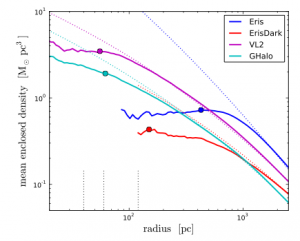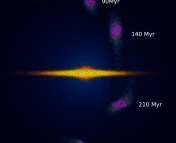TITLE: An Off-Center Density Peak in the Milky Way’s Dark Matter Halo?
AUTHORS: Michael Kuhlen, Javiera Guedes, Annalisa Pillepich, Piero Madau, Lucio Mayer
FIRST AUTHOR’S INSTITUTION: UC-Berkeley
Any high-energy astrophysicist can tell you about the rumblings as of late that have been focusing around the 130 GeV line. As Astrobites reported a couple of months ago, the Fermi-LAT gamma-ray telescope has reported an anomalous peak at 130 GeV, which could be the long-sought annihilation signature of dark matter.
If this is true, it will be a big development – the first detection of a signal from dark matter. Dark matter has traditionally been observed only by its gravitational effect on normal matter, such as in the rotation curves of galaxies and the lensing of galactic clusters. Detecting the annihilation signature would be a big piece of evidence in favor of the WIMP theory of dark matter, which posits that dark matters consists of an unknown weakly-interacting massive particle outside the Standard Model. Not only would such a signature be the first signal of true physics beyond the Standard Model, but the energy and form of it would tell us quite a bit about that new physics.
However, since this discovery would have such weighty implications, it’s important to ensure we aren’t jumping to conclusions. Alternate explanations for the 130 GeV line have been proposed, such as that by Aharonian et al. 2012, who explained how a pulsar wind nebula could generate a 130 GeV “line” via lepton interactions. One of the strongest critiques of the discovery so far has been the fact that the signal is not coming from Sgr A*, but rather from about 1.5 degrees (~200 parsecs) away. Sgr A* is the Milky Way’s supermassive black hole and sits at the dynamical center of the galaxy; it is generally assumed (and is seen in simulation) that the dark matter distribution of a galaxy should also peak at the dynamical center. Since the strongest annihilation signature should be coming from the densest concentration of dark matter, the 130 GeV line should be strongest at Sgr A*, rather than 200 parsecs away from it.

Density profiles for the center regions of four galaxy simulations. The location of maximum dark matter density is marked by a filled circle. The Eris simulation (blue curve) has its dark matter peak offset much further from the dynamical center than the other three simulations.
However, today’s paper by Kuhlen et al. challenges this idea. They test the assumption that the dark matter peak is located at the dynamical center by examining four major galaxy formation simulations. Three of these simulations (ErisDark, Via Lactea II, and GHalo) are dark matter only, while one (Eris) models both dark matter and baryonic matter. They find that while the dark-matter-only galaxies keep their density peak at the dynamical center, the combined dark matter-baryonic matter simulation shows a well-defined, consistent offset, as much as 300 – 400 parsecs.
The growth of this offset corresponds with the growth of a “core” in the Eris simulation, a possible clue to its origin. The typical dark matter profile of a galaxy has a “cusp” at the center – a region of sharply peaked density. However, observations of real galaxies suggest that the dark matter profile is closer to a “cored” profile – it has a region of largely uniform density at its center. Dark-matter-only galaxy simulations show a cusped profile, while dark matter plus baryonic matter simulations show a cored profile. This suggests that the same baryonic processes responsible for Eris’ core may be responsible for offsetting the density peak.
The authors consider three explanations for this offset: statistical fluctuations; a partially dissolved subhalo core; and perturbation by some external force such as a galactic bar. Statistical tests rule out the fluctuation explanation for the peak. The subhalo explanation posits that the galaxy accreted a smaller dark matter halo that has not yet been completely disrupted. However, this would suggest that the offset density peak would be a bound structure of specific particles held together by gravity, but following the peak through the simulation shows that particles move in and out of the peak rather than staying bound to it. The last explanation, excitation by some perturber, seems the most likely. In this scenario the stellar bar in the Eris galaxy excites a resonance in the dark matter distribution, tugging the peak off-center. This conclusion is buoyed by the fact that the offset appears at roughly the same time as the bar, and tends to be offset in the direction of the bar.
Kuhlen et al.’s results show that a dark matter peak might be displaced as much as 2.5 degrees from the galactic center, which puts the 130 GeV line detection well within the realm of possibility. However, they were not able to resolve the full structure of the peak, important for determining the expected contrast between the peak and its surroundings. Further results may have to wait for the completion of a higher-resolution run of the Eris simulation, not expected to finish for several more months. But it’s clear that, between this gamma ray signature and the detection of the Higgs, exciting things are happening around 130 GeV.




